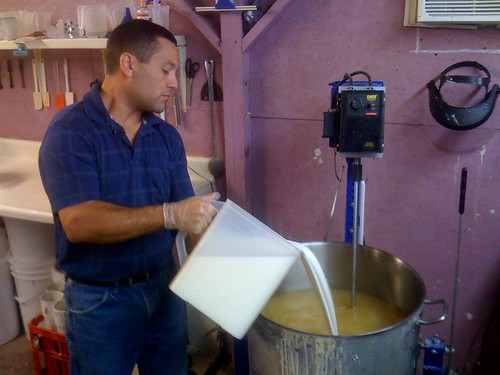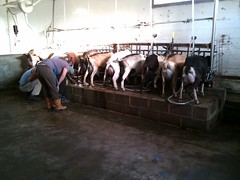Making Goats Milk Soap

Image by Indiana Public Media
From the November 11th episode of The Weekly Special, seen on WTIU Thurday evenings at 8pm and Fridays at 6pm. Watch the episode»
Photo: WTIU
Learn more at Goatmilkstuff.com
Article by Joe Lapham
The most popular making process today is the cold process method, where fats such as olive oil react with lye, while some soapers use the historical hot process.
Handmade soap differs from industrial soap in that, usually, an excess of fat is sometimes used to consume the alkali (superfatting), and in that the glycerin is not removed, leaving a naturally moisturising soap and not pure detergent. Superfatted soap, soap which contains excess fat, is more skin-friendly than industrial soap, though if too much fat is added, it can leave users with a “greasy” feel to their skin.
Often, emollients such as jojoba oil or shea butter are added ‘at trace’ (the point at which the saponification process is sufficiently advanced that the soap has begun to thicken), after most of the oils have saponified, so that they remain unreacted in the finished soap. Superfatting can also be accomplished through a process called superfat discount, where, instead of putting in extra fats, the soap maker puts in less lye.
Reacting fat with Sodium hydroxide will produce a stable soap that will usually become firmer as it cures. Reacting fat with potassium hydroxide will produce a soap that is either soft or liquid.
Historically, the alkali used was potassium hydroxide made from the ashes of bracken or from wood ashes.
Soap is derived from either vegetable or animal fats. Sodium tallowate, a common ingredient in many soaps, is derived from rendered beef fat. Soap can also be made of vegetable oils, such as palm oil, and the product is typically softer. If soap is made from pure olive oil it may be called Castile soap or Marseille soap. Castile is also sometimes applied to soaps with a mix of oils, but a high percentage of olive oil.
An array of saponifiable oils and fats are used in the process such as olive, coconut, palm, cocoa butter, hemp oil and shea butter to provide different qualities. For example, olive oil provides mildness in soap; coconut oil provides lots of lather; while coconut and palm oils provide hardness. Sometimes castor oil can also be used as an ebullient. Most common, though, is a combination of coconut, palm, and olive oils when soap making.
Smaller amounts of unsaponifiable oils and fats that do not yield soap are sometimes added for further benefits. Below is a resource that you will thank me for later. It is complete how to instructions.
You’ll enjoy our site here. http://www.backtobasics-homestead.com/

